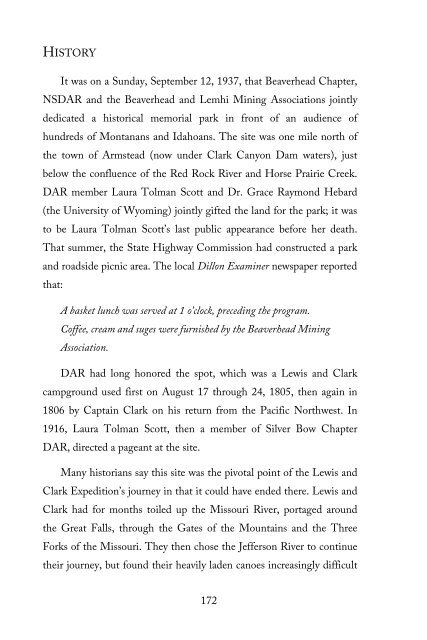Montana's DAR Markers . . . Honoring Where History Was Made
This book is a 200-page thank you to the women of Montana State Society Daughters of the American Revolution for their work in placing historical markers across the state of Montana. Starting in 1908, Montana DAR has installed 70 historical markers across the state. Of those, 33 remain. This book records why the markers’ sites were selected, their history, and the backstory of each.
This book is a 200-page thank you to the women of Montana State Society Daughters of the American Revolution for their work in placing historical markers across the state of Montana. Starting in 1908, Montana DAR has installed 70 historical markers across the state. Of those, 33 remain. This book records why the markers’ sites were selected, their history, and the backstory of each.
You also want an ePaper? Increase the reach of your titles
YUMPU automatically turns print PDFs into web optimized ePapers that Google loves.
HISTORY<br />
It was on a Sunday, September 12, 1937, that Beaverhead Chapter,<br />
NS<strong>DAR</strong> and the Beaverhead and Lemhi Mining Associations jointly<br />
dedicated a historical memorial park in front of an audience of<br />
hundreds of Montanans and Idahoans. The site was one mile north of<br />
the town of Armstead (now under Clark Canyon Dam waters), just<br />
below the confluence of the Red Rock River and Horse Prairie Creek.<br />
<strong>DAR</strong> member Laura Tolman Scott and Dr. Grace Raymond Hebard<br />
(the University of Wyoming) jointly gifted the land for the park; it was<br />
to be Laura Tolman Scott’s last public appearance before her death.<br />
That summer, the State Highway Commission had constructed a park<br />
and roadside picnic area. The local Dillon Examiner newspaper reported<br />
that:<br />
A basket lunch was served at 1 o’clock, preceding the program.<br />
Coffee, cream and suges were furnished by the Beaverhead Mining<br />
Association.<br />
<strong>DAR</strong> had long honored the spot, which was a Lewis and Clark<br />
campground used first on August 17 through 24, 1805, then again in<br />
1806 by Captain Clark on his return from the Pacific Northwest. In<br />
1916, Laura Tolman Scott, then a member of Silver Bow Chapter<br />
<strong>DAR</strong>, directed a pageant at the site.<br />
Many historians say this site was the pivotal point of the Lewis and<br />
Clark Expedition’s journey in that it could have ended there. Lewis and<br />
Clark had for months toiled up the Missouri River, portaged around<br />
the Great Falls, through the Gates of the Mountains and the Three<br />
Forks of the Missouri. They then chose the Jefferson River to continue<br />
their journey, but found their heavily laden canoes increasingly difficult<br />
172





